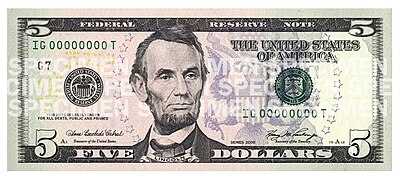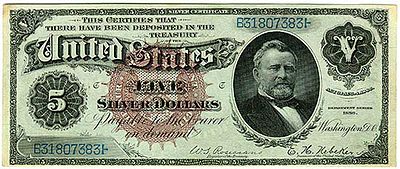What Is on the Back of the 5 Dollar Bill

The United States $5 bill is a denomination of U.S. currency. The bill currently features U.S. President Abraham Lincoln's portrait on the front and the Lincoln Memorial on the back. All $5 bills issued today are Federal Reserve Notes.

The Bureau of Engraving and Printing says the "average life" of a $5 bill in circulation is 16 months in circulation before it is replaced due to wear. Approximately 9% of all paper currency produced by the U.S. Treasury's Bureau of Engraving and Printing today are $5 bills.

Front of the 2006 Series $5 bill
The Redesigned $5 Bill [edit | edit source]
The redesigned $5 bill was unveiled on 9/20/2007, and was issued on 3/13/2008. New and enhanced security features make it easier to check the new $5 bill and more difficult for potential counterfeiters to reproduce. The new $5 bill has:
- Watermarks: There are now two watermarks on the redesigned $5 bill. A large number "5" watermark is located in a blank space to the right of the portrait replacing the previous watermark portrait of President Lincoln found on the older design of $5 bills. A second watermark - a new column of three smaller "5"s - has been added to the new $5 bill design and is positioned to the left of the portrait.
- Security Thread: The embedded security thread runs vertically and is now located to the right of the portrait on the redesigned $5 bill. The letters "USA" followed by the number "5" in an alternating pattern are visible along the thread from both sides of the bill. The thread glows blue (the previous bills glowed white) when held under ultraviolet light.
Design Features [edit | edit source]
The new $5 bills will remain the same size and will use the same (but enhanced) portraits and historical images. The most noticeable difference in the redesigned $5 bill is the addition of light purple in the center of the bill, which blends into gray near the edges.
Similar to the recently redesigned $10, $20, and $50 bills, the new $5 bill features an American symbol of freedom printed in the background: The Great Seal of the United States, an eagle and shield, is printed in purple on the back of the bill.
Additional Design Elements Include: [edit | edit source]
- On the back of the bill, a larger, purple number "5" appears in the lower right corner to help those with visual impairments to distinguish the denomination.
- The oval borders around President Lincoln's portrait on the front, and the Lincoln Memorial vignette on the back have been removed. Both engravings have been enhanced.
- An arc of purple stars surrounds the portrait and The Great Seal on the front of the bill, and small yellow "05"s are printed on the front and back of the bill.
- Small yellow "05"s are printed to the left of the portrait on the front of the bill and to the right of the Lincoln Memorial vignette on the back.
Other Features [edit | edit source]
- Microprinting: Because they are so small, microprinted words are hard to replicate. The redesigned $5 bill features microprinting, which is the engraving of tiny text, on the front of the bill in three areas: the words "FIVE DOLLARS" can be found repeated inside the left and right borders of the bill; the words "E PLURIBUS UNUM" appear at the top of the shield within the Great Seal; and the word "USA" is repeated in between the columns of the shield. On the back of the bill the words "USA FIVE" appear along one edge of the large purple "5" low-vision feature.
- Federal Reserve Indicators: A universal seal to the left of the portrait represents the entire Federal Reserve System. A letter and number beneath the left serial number identifies the issuing Federal Reserve Bank.
- Serial Numbers: The unique combination of eleven numbers and letters appears twice on the front of the bill. On the new $5 bill, the left serial number has shifted slightly to the right, compared with previous designs.
More Information [edit | edit source]
- http://www.moneyfactory.gov/newmoney/
- http://www.federalreserve.gov/
- http://www.secretservice.gov/
Large Size Note history [edit | edit source]
(≈ 7.1418 x 3.125 in ≅ 189 x 79 mm)
- 1861: The first $5 bill was issued as a Demand Note with a small portrait of Alexander Hamilton on the right and an allegorical statue representing freedom on the left side of the obverse.
- 1862: The first $5 United States Note was issued with a face design similar to the previous Demand Note and a completely revised reverse.
- 1869: A new $5 United States Note was issued with a small portrait of Andrew Jackson on the left and a vignette of a pioneer family in the middle.
- 1870: National Gold Bank Notes were issued specifically for payment in gold coin by participating banks. The obverse featured vignettes of Christopher Columbus sighting land and Columbus with an Indian princess; the reverse featured U.S. gold coins.
- 1875: The series 1869 United States Note was revised. The green tinting that was present on the obverse was removed and the design on the reverse was completely changed.
- 1886: The first $5 Silver Certificate was issued with a portrait of Ulysses S. Grant on the obverse and five Morgan silver dollars on the reverse.

- 1890: Five dollar Treasury or "Coin Notes" were issued and given for government purchases of silver bullion from the silver mining industry. The reverse featured an ornate design that occupied almost the entire note.
- 1891: The reverse of the 1890 Treasury Note was redesigned because the treasury felt that it was too "busy" which would make it too easy to counterfeit.
- 1891: The reverse of the 1886 Silver Certificate was revised; the 5 Morgan silver dollars were removed.
- 1896: The famous "Educational Series" Silver Certificate was issued. The entire obverse was covered with artwork representing electricity and the reverse featured portraits of Ulysses Grant and Phillip Sheridan.

Famous 1896 $5 "Educational Series" Silver Certificate

- 1899: A new $5 silver certificate with a portrait of Running Antelope on the face was issued.
- 1914: The first $5 Federal Reserve Note was issued with a portrait of Lincoln on the obverse and vignettes of Columbus sighting land and the Pilgrim's landing on the reverse. The note initially had a red treasury seal and serial numbers; however, they were changed to blue.
- 1915: Federal Reserve Bank Notes (not to be confused with Federal Reserve Notes) were issued by 5 Federal Reserve Banks. The obverse was similar to the 1914 Federal Reserve Notes, except for large wording in the middle of the bill and a portrait with no border on the left side of the bill. Each note was an obligation of the issuing bank and could only be redeemed at the corresponding bank.
- 1918: The 1915 Federal Reserve Bank Note was re-issued under series 1918 by 11 Federal Reserve banks.
- 1923: The $5 silver certificate was redesigned; it was nicknamed a "porthole" note due to the circular wording of THE UNITED STATES OF AMERICA around Lincoln's portrait. The reverse featured the Great Seal of the United States.

1923 "porthole" silver certificate
Small Size Note History [edit | edit source]
(6.14 x 2.61 in ≅ 156 x 66 mm)
- 1929: Under Series of 1928, all small-sized notes carried a standardized design. All $5 bills would feature a portrait of Lincoln, the same border design on the obverse, and the Lincoln Memorial on the reverse. The $5 bill was issued as a United States Note with a red seal and serial numbers and as a Federal Reserve Note with a green seal and serial numbers.
- 1933: As an emergency response to the Great Depression, additional money was pumped into the American economy through Federal Reserve Bank Notes. This was the only small-sized $5 bill that had a different border design. The serial numbers and seal on it were brown.
- 1934: The redeemable in gold clause was removed from Federal Reserve Notes due to the U.S. withdrawing from the gold standard.
- 1934: The first $5 Silver Certificates were issued with a blue seal and serial numbers along with a blue numeral 5 on the left side of the obverse.
- 1942: Special World War II currency was issued. HAWAII was overprinted on the front and back of the $5 Federal Reserve Note; the seal and serial numbers were changed to brown from green. This was done so that the currency could be declared worthless if there was a Japanese invasion. A $5 silver certificate was printed with a yellow instead of blue treasury seal; these notes were for U.S. troops in North Africa. These notes, too, could be declared worthless if seized by the enemy.
- 1950: Many minor aspects on the obverse of the $5 Federal Reserve Note were changed. Most noticeably, the treasury seal, gray word FIVE, and the Federal Reserve Seal were made smaller; also, the Federal Reserve seal had spikes added around it.
- 1953: New $5 United States Notes and Silver Certificates were issued with a gray numeral 5 on the left side of the bill and the gray word FIVE with a blue seal imprinted over it on the right and blue serial numbers.
- 1963: Both the $5 United States Note and Federal Reserve Note were revised with the motto IN GOD WE TRUST added to the reverse and WILL PAY TO THE BEARER ON DEMAND removed from the obverse. Also, the obligation on the Federal Reserve Note was changed to its current wording, THIS NOTE IS LEGAL TENDER FOR ALL DEBTS PUBLIC AND PRIVATE.

Series 1963 $5 United States Note. Urban legend erroneously holds that the red seal from that year onward was done in mourning of the Kennedy assassination
- 1967: Production of the $5 United States Note ends.
- 1969: The $5 bill began using the new treasury seal with wording in English instead of Latin.
- 1993: The first new-age anti-counterfeiting measures were introduced with microscopic printing around Lincoln's portrait and a plastic security strip on the left side of the bill.
- May 24, 2000: To combat evolving counterfeiting, a new $5 bill was issued under series 1999 whose design was similar in style to the $100, $50, and $20 bills that had all undergone previous design changes. The $5 bill, however, does not feature color-shifting ink like all the other denominations.
- June 28, 2006: The BEP announced plans to redesign the $5 note, likely with similar features as newer $10, $20, and $50 notes.
- September 20, 2007: The BEP revealed the redesigned $5 note to the public.The new bill began circulating on March 13, 2008.
Reverse Side [edit | edit source]
On the back of the $5 bill the following states names are written at the top of the Lincoln Memorial in this order: Top
- Arkansas
- Michigan
- Florida
- Texas
- Iowa
- Wisconsin
- California
- Minnesota
- Oregon
- Kansas
- West Virginia
- Nevada
- Nebraska
- Colorado
- North Dakota
Bottom
- Delaware
- Pennsylvania
- New Jersey
- Georgia
- Connecticut
- Massachusetts
- Maryland
- Carolina
- New Hampshire
- Virginia
- New York
--km 01:11, 20 January 2008 (UTC)
What Is on the Back of the 5 Dollar Bill
Source: https://en.wikiversity.org/wiki/United_States_currency/$5_bill